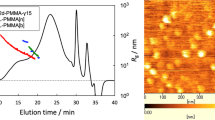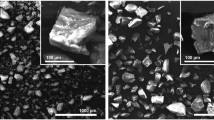Abstract
ALTHOUGH a great many examples of naturally occurring and synthetic inorganic sheet polymers are known1,2, very little work has been done on their organic counterparts. Planar organic macromolecules have attracted a considerable amount of interest because of the unusual properties they are expected to possess, but they have proved difficult to synthesize and there is a distinct lack of information about their properties. Synthesis may be approached either by carrying out the polymerization at an interface3,4, or on a surface5,6, or by using a monomer which for steric reasons is constrained to polymerize in two dimensions7. The polymerization of methyl meth-acrylate adsorbed in the interlayers of montmorillonite by means of γ-rays has been studied by Blumstein5. The resulting interlayer polymer was resistant to the usual solvent extraction procedures and could be isolated only by dissolving out the silicate lattice with hydrofluoric acid, a treatment liable to damage most polymers. From the dilute solution properties of the polymer it was deduced that the interlayer polymethyl methacrylate developed a two-dimensional sheet structure when a cross-linking agent was present during the polymerization8. I report here the results of attempts to prepare organic sheet polymers on the surface of a synthetic calcium aluminate hydrate of composition 4CaO·Al2O3·xH2O (ref. 9). This mineral was selected because it can be made in a pure state, because it has a layer structure, and because it is capable of intercalating a wide range of organic materials9 and is soluble in dilute hydrochloric acid.
This is a preview of subscription content, access via your institution
Access options
Subscribe to this journal
Receive 51 print issues and online access
$199.00 per year
only $3.90 per issue
Buy this article
- Purchase on Springer Link
- Instant access to full article PDF
Prices may be subject to local taxes which are calculated during checkout
Similar content being viewed by others
References
Holliday, L., Chem. Ind., 970 (1967).
Currell, B. R., and Frazer, M. J., RIC Rev., 2, 13 (1969).
Gee, G., and Rideal, E. K., Proc. Roy. Soc., 153, 116 (1935).
Bresler, S., Judin, M., and Talmud, D., Ada Physicochim. USSR, 14, 71 (1941).
Blumstein, A., J. Poly. Sci., A3, 2665 (1965).
Glavati, O. L., Polak, L. S., and Shchekin, V. I., Neftekhimiya, 3, 905 (1963).
Huggins, M., Proc. Intern. Symp. Macromol. Chem., Prague (1965).
Blumstein, A., and Billmeyer, jun., F. W., J. Poly. Sci., A4, 465 (1966).
Dosch, W., Clays and Clay Minerals, 15, 273 (1967).
Blumstein, A., and Blumstein, R., Poly. Lett., 5, 691 (1967).
Author information
Authors and Affiliations
Rights and permissions
About this article
Cite this article
THENK, B. Formation of Two-dimensional Organic Polymers on a Mineral Surface. Nature 228, 853–854 (1970). https://doi.org/10.1038/228853b0
Received:
Issue Date:
DOI: https://doi.org/10.1038/228853b0
This article is cited by
-
Nano-confined crystallization of organic ultrathin nanostructure arrays with programmable geometries
Nature Communications (2019)
Comments
By submitting a comment you agree to abide by our Terms and Community Guidelines. If you find something abusive or that does not comply with our terms or guidelines please flag it as inappropriate.



